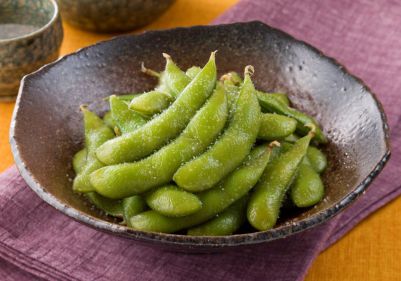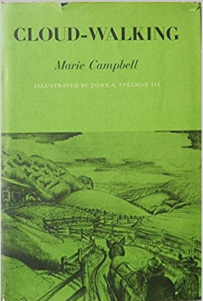My first monthly feature plant for the year are the beautiful, bountiful buddleias, which are in full bloom this month. Also spelt Buddlejas and known as Butterfly Bush, due to its popularity with butterflies; Summer Lilac and Bombsite Plant (see later), they were named by Linnaeus after Reverend Adam Buddle (1660-1715), an English botanist and taxonomist, who produced 36 volumes dedicated to British native flora (volumes 14 to 36 about mosses alone)!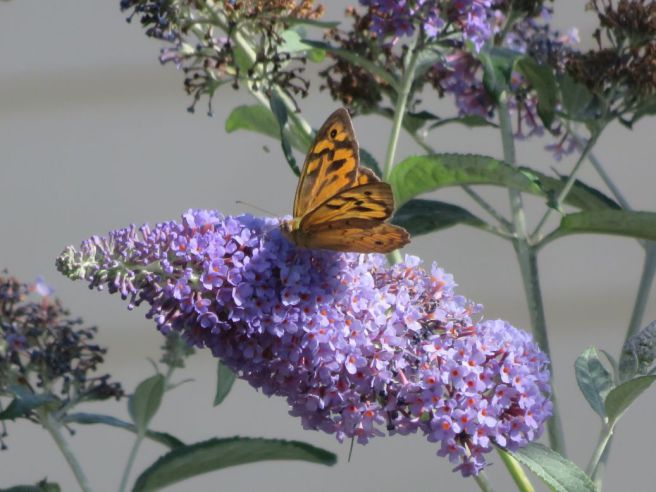 They belong to the Foxglove family Scrophulariaceae (Buddlejaceae), with the genus containing at least 100 species (some sources number 140) and numerous decorative cultivars. They hail from four continents: Asia; North and South America: 60 species from Southern USA to Chile; and Africa, with no buddleias native to Europe or Australasia.
They belong to the Foxglove family Scrophulariaceae (Buddlejaceae), with the genus containing at least 100 species (some sources number 140) and numerous decorative cultivars. They hail from four continents: Asia; North and South America: 60 species from Southern USA to Chile; and Africa, with no buddleias native to Europe or Australasia.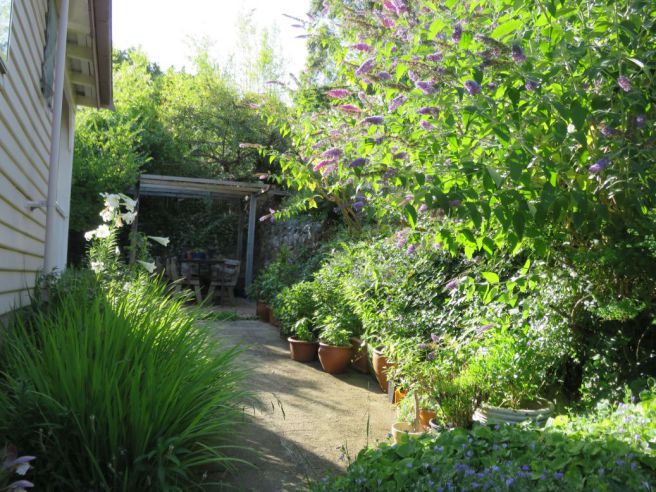 Please note that because I inherited my buddleias, which were already well-established in our garden, when we arrived, I do not know their names, though I assume they are all forms of B. davidii, hence my photographs will be identified solely by their colour!
Please note that because I inherited my buddleias, which were already well-established in our garden, when we arrived, I do not know their names, though I assume they are all forms of B. davidii, hence my photographs will be identified solely by their colour!
While I will try to be consistent with my spelling, generally restricting myself to using ‘buddleia’, the odd ‘buddleja’ might still slip in, especially when the latter spelling is used in the names of plants or plant collections!
Description
Large, sprawling, deciduous (temperate climes) or evergreen shrubs (tropical areas) shrubs, usually less than 5 metres tall, though they can reach 9 metres tall.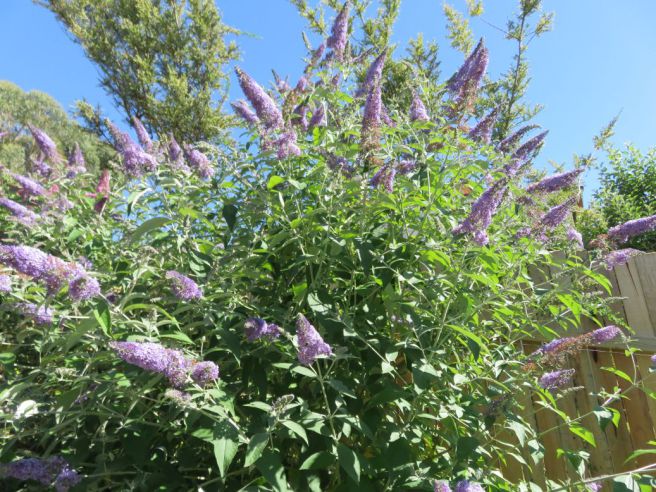 Long, narrow, lanceolate leaves, arranged in opposite pairs, except for B. alternifolia, in which the leaves are arranged alternately. Leaf size varies from 1 to 30 cm long. The leaves are often crepe-textured with pale, sometimes downy, undersides. Some species are silvery grey, while others are a dull matte green.
Long, narrow, lanceolate leaves, arranged in opposite pairs, except for B. alternifolia, in which the leaves are arranged alternately. Leaf size varies from 1 to 30 cm long. The leaves are often crepe-textured with pale, sometimes downy, undersides. Some species are silvery grey, while others are a dull matte green. Buddleias are grown for their flowers. Many have long, nectar-rich flower spikes, but some occur in spherical heads or loose clusters. The Asiatic species have terminal panicles, 10 to 50 cm long, and tend to be pastel pink or mauve, while the American species have cymes, forming small globose heads, which are often red, orange or yellow. Many cultivars have deeper colours, including a rich reddish-purple.
Buddleias are grown for their flowers. Many have long, nectar-rich flower spikes, but some occur in spherical heads or loose clusters. The Asiatic species have terminal panicles, 10 to 50 cm long, and tend to be pastel pink or mauve, while the American species have cymes, forming small globose heads, which are often red, orange or yellow. Many cultivars have deeper colours, including a rich reddish-purple.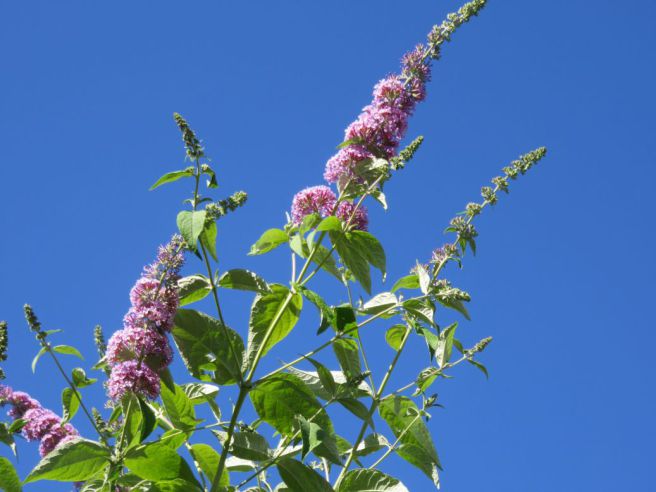 Each individual flower is tubular and divided into four spreading lobes (petals), 3 to 4 mm across. The corolla length again varies according to the species. Asiatic species have a 10 mm long corolla, while American species vary from 3 to 30 mm, the latter having long red flowers, pollinated exclusively by hummingbirds. Some species are fragrant and strongly honey-scented, attracting not only butterflies, but also moths and bees.
Each individual flower is tubular and divided into four spreading lobes (petals), 3 to 4 mm across. The corolla length again varies according to the species. Asiatic species have a 10 mm long corolla, while American species vary from 3 to 30 mm, the latter having long red flowers, pollinated exclusively by hummingbirds. Some species are fragrant and strongly honey-scented, attracting not only butterflies, but also moths and bees. Flowering times vary according to the species, but generally they flower from Spring to Autumn. We had our first bloom in mid-November last year.
Flowering times vary according to the species, but generally they flower from Spring to Autumn. We had our first bloom in mid-November last year. The fruit is a small capsule, 1 cm long and 1 to 2 mm diameter with numerous small seeds.
The fruit is a small capsule, 1 cm long and 1 to 2 mm diameter with numerous small seeds.
Use and Care
Buddleias are usually grown for their flowers, as a feature plant and as a butterfly food plant, though B. davidii yields dyes (black and green from mixed flowers, leaves and stems, while the flowers alone produce an orange-gold to brown colour); and B. officinalis and B. asiaticum are used in traditional Chinese and Korean medicine and. See: http://www.chineseherbshealing.com/butterfly-bush/.
They are extremely hardy and tough, the deciduous species being hardier than the evergreens, though none will tolerate prolonged severe Winters. They are incredibly easy to grow and undemanding, tolerating salty air, drought, shade, urban pollution and most soil types, though they have a preference for chalky and limey soils.
Best in full sun on a moist, fertile well-drained soil, they grow incredibly quickly and some species can become invasive (more later).
They spread easily by seed and can be propagated easily by half-hardened soft wood cuttings taken in late Spring and early Summer. Cut a 15 cm new shoot, just as it is beginning to harden up, trim below the leaf node and nip out the top, then remove any large leaves. Dip the cut end into hormone rooting powder or honey (though it really doesn’t need it!) and plant in a 50/50 mixture of horticultural sand and compost.
They should be deadheaded constantly throughout the flowering season to encourage more flowers and prevent self-seeding and then pruned back to within 3 to 6 inches of the old wood in very early Spring, around crocus time, removing all dead wood. I am referring to the most common Butterfly Bush, B. davidii, here.
Pests include capsid bugs, caterpillars, nematodes (when grown in sandy soils) and red spider mite (especially during droughts). Neem Oil is a good organic treatment for all infestations. Buddleias can also experience root rot, if growing in swampy ground, and downy mildew, if grown in a cool climate with extended periods of rain.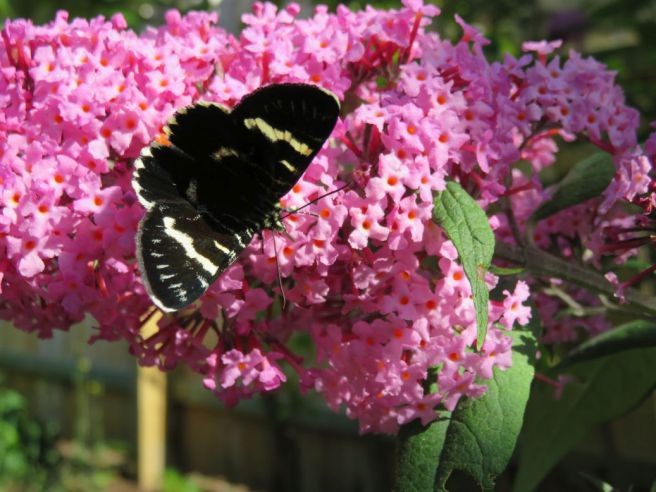 Species and Cultivars
Species and Cultivars
B. globosa : Orange Ball Tree
See: https://www.rhs.org.uk/Plants/2453/Buddleja-globosa/Details
Buddleias are mostly 20th century plants, except for Buddleja globosa, which was introduced to Britain from Chile in 1774. It is semi-evergreen, 5m tall and wide, and produces highly fragrant, honey-scented, orange globular inflorescences on branches from the previous season’s growth.
B. colvilei : Himalayan Butterfly Bush/ Tree Buddleia See: https://lambley.com.au/plant/buddleja-colvilei and http://www.louistheplantgeek.com/a-gardening-journal/802-buddleja-colvilei.
2 to 6 metres tall deciduous shrub or small tree with dark pink flowers in Summer.
B. paniculata See: http://www.buddlejacollection.com/plants/paniculata/
Deciduous 6 metre tall shrub from East Asia and Northern India.
B. alternifolia: Weeping Butterfly Bush/ Alternate-Leaved Butterfly Bush or Fountain Butterfly Bush
A weeping, semi-deciduous, 5 metre tall shrub, native to North-West China (Kansu), which also produces flowers on older wood, and whose leaves are arranged alternately along the stems. For an image, see: https://www.rhs.org.uk/Plants/2441/Buddleja-alternifolia/Details and https://lambley.com.au/plant/buddleja-alternifolia-argentea.
B. asiatica: Bai Bei Feng or Dog Tail/ Asian Butterfly Bush.
See: https://wildlifeofhawaii.com/flowers/904/buddleja-asiatica-dogtail/
A 3 metre tall and wide evergreen shrub, whose dried and powdered root is used to make a fermented liquor, used as an abortifacient and to treat skin problems in traditional Chinese medicine.
B. officinalis: Mi Meng Hua
See: https://www.rhs.org.uk/Plants/85046/Buddleja-officinalis/Details
A 2.5 to 4 metre tall, early Spring-flowering, semi-evergreen shrub, native to East Asia and Western China, whose flowers (dried or fresh) are used to make a tea used in the treatment of ophthalmic conditions eg Corneal Opacity; Glaucoma and Nebula. The leaves, flowers and roots contain a large variety of flavonoid, triterpenoid and iridoid glycosides, which have been shown to repair damaged cell membrane of lens, prevent protein denaturation in the lens, reduce lens opacity and restore vision.
In traditional Korean medicine, the flowers and flower buds are also used to treat eye problems, as well as cramps and spasms caused by problems with the intestine, bladder or stomach eg Irritable Bowel Syndrome. The leaves are used to treat gonorrhoea, hepatitis and hernias.
The flowers of B.officinalis are also used to dye rice yellow in sticky rice dish, Hao Leng, and Five Coloured Rice, Wu Se Fan.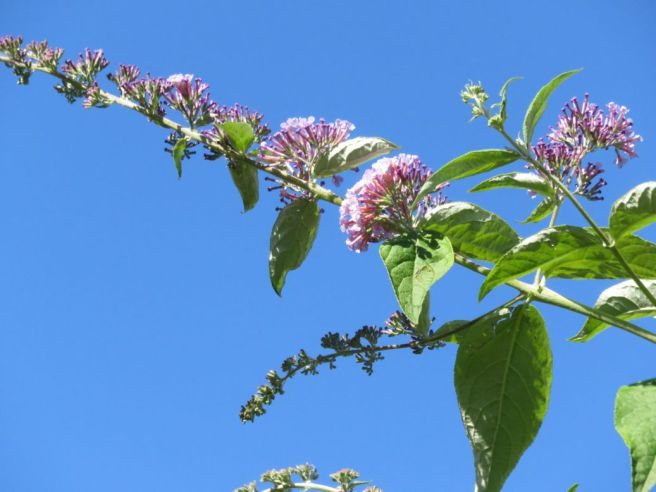 B. davidii (B. variabilis)
B. davidii (B. variabilis)
The most popular cultivated Buddleia species and a semi-evergreen, open arching shrub, 1.2 to 4.6 metres tall and wide. It is native to Central China (Sichuan and Hubei provinces) and Japan.
It was introduced to Kew in 1896 (180 years after Buddle’s death) and was named after another clergyman, a French missionary called Père Armand David (1826-1900), who travelled over 7000 miles by foot in Asia and was the first European to see it flowering on stony rocky slopes in China. David collected 1500 plants in his travels, including 250 new species and 11 new genera, including the Handkerchief Tree, Davidia involucrata.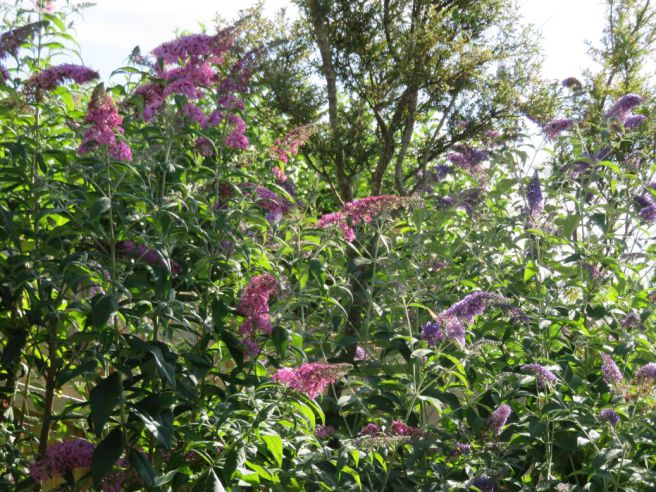 B. davidii is highly invasive and colonises dry open ground very quickly, including railway track sidings (see http://www.bbc.com/news/magazine-28196221); derelict factories and urban bombsites, hence its name, the Bombsite Plant.
B. davidii is highly invasive and colonises dry open ground very quickly, including railway track sidings (see http://www.bbc.com/news/magazine-28196221); derelict factories and urban bombsites, hence its name, the Bombsite Plant.
Both the species and its cultivars have been banned in many states in the United States of America (eg Oregon and Washington), and it certainly has naturalised very successfully in Northern Australia.
There are interspecific hybrids like Buddleja ‘Lochinch’, a cross between B. davidii and B. fallowiana; and B. x weyeriana, a cross between B. davidii and B. globosa; and at least 180 B. davidii cultivars. Some of the most popular garden cultivars are Royal Red (rich magenta), Black Knight (dark purple) and Empire Blue (small blue spikes), all three being taller older varieties, as well as Sungold (golden yellow) and Pink Delight, the latter bred in Holland in 1990, a compact shrub with silvery foliage and fragrant long, pure pink flower spikes. Dartmouth is another tall hybrid, 5 metres tall, with magenta-purple hand-shaped blooms, whose spikes radiate from one ‘palm’.
Some of the most popular garden cultivars are Royal Red (rich magenta), Black Knight (dark purple) and Empire Blue (small blue spikes), all three being taller older varieties, as well as Sungold (golden yellow) and Pink Delight, the latter bred in Holland in 1990, a compact shrub with silvery foliage and fragrant long, pure pink flower spikes. Dartmouth is another tall hybrid, 5 metres tall, with magenta-purple hand-shaped blooms, whose spikes radiate from one ‘palm’.
There are compact varieties, suitable for smaller gardens, like the pink Peacock ; Purple Emperor; Adonis Blue; Marbled White; and Camberwell Beauty (like a dwarf Dartmoor), the last four named after British butterflies. Nanho Blue (blue) and Nanho Purple (purple) are both dainty hybrids, only 1.5 metres tall, with delicate long slender flower spikes.
Other hybrids include: African Queen (dark purple); Blue Horizon (clear blue); Petite Indigo (lavender- blue); Darent Valley, Nanho White, White Profusion and White Bouquet– all white; and Opera (pink). See: https://en.wikipedia.org/wiki/Category:Buddleja_hybrids_and_cultivars; and https://www.plantdelights.com/blogs/articles/butterfly-bush-buddleia-davidii-plant-buddleja for more species and hybrids. In the United Kingdom, there are 4 NCCPG national collections, including:
In the United Kingdom, there are 4 NCCPG national collections, including:
- The Lavender Garden, Ashcroft Nurseries, Kingscote, Tetbury, Glos. GL8 8YF. Tel. 01453 860356 www.thelavenderg.co.uk; and http://www.thelavenderg.co.uk/buddleja.htm;
- Longstock Park Nursery, Longstock, Stockbridge, Hants. SO20 6EH. Tel. 01264 810894 , part of the Leckford Estate https://leckfordestate.co.uk;
- Paignton Zoo, Totnes Road, Paignton, Devon TQ4 7EU. Tel. 01803 697529 www.paigntonzoo.org.uk and https://www.paigntonzoo.org.uk/explore/news/detail/zoo-gardener-branches-out;
- The Shapcott Barton Estate, East Knowstone, South Molton, Devon EX36 4EE. Tel. 01398 341664.
Peter Moore (http://bredbypetermoore.co.uk/) of Longstock Park Nursery (https://leckfordestate.co.uk/nursery) has been breeding more compact (1 to 2 meters tall), sterile buddleias for over 20 years, which flower for a longer period without self-seeding. He produces 50 Buddleia crosses each year, trialling the most promising hybrids in the garden, and spends 10 hours every week, deadheading all the Buddleias in the collection. Longstock Park Nursery has two Plant Heritage Collections, one of Clematis viticella, the other of Buddleias, as well as holding the Gilchrist Collection of Penstemons.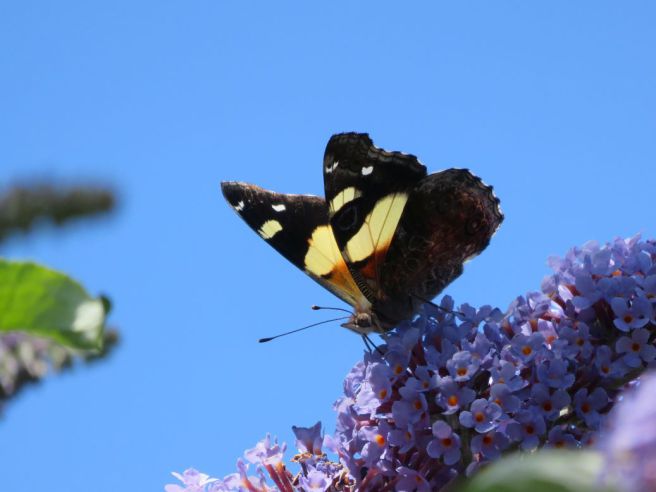 The Buddleja Collection started as a deer- and rabbit-proof screening hedge along the old tennis court and now contains 160 species and cultivars, some of them tender. The aim is to conserve, grow, document and celebrate buddlejas growing in the United Kingdom. See :https://leckfordestate.co.uk/nursery-plants/buddleja-stock-list for the stock list of Buddlejas held.
The Buddleja Collection started as a deer- and rabbit-proof screening hedge along the old tennis court and now contains 160 species and cultivars, some of them tender. The aim is to conserve, grow, document and celebrate buddlejas growing in the United Kingdom. See :https://leckfordestate.co.uk/nursery-plants/buddleja-stock-list for the stock list of Buddlejas held. The collection includes:
The collection includes:
Sugar Plum: a compact form of B. davidii, with the reddest flowers of all buddleias;
Pink Pagoda: a pale pink form of B. x weyeriana;
Blue Chip: 0.6 to 0.9 metre high compact shrub with lavender-blue flowers with sterile seed; and
Silver Anniversary: A cross between B. loricata from South Africa and the lilac-pink B. crispa from Northern India, Bhutan, Nepal, Pakistan, Afghanistan and China, with the best silver foliage of any hardy buddleja. See: http://www.buddlejacollection.com/collections/ for the whole collection.  Here is another useful link for further reading on Buddlejas: http://www.buddlejagarden.co.uk/linx.html.
Here is another useful link for further reading on Buddlejas: http://www.buddlejagarden.co.uk/linx.html.
Next week, we are discussing the other dominant highlight of Summer, the Cockatoo and Parrot Family!
Share this:


